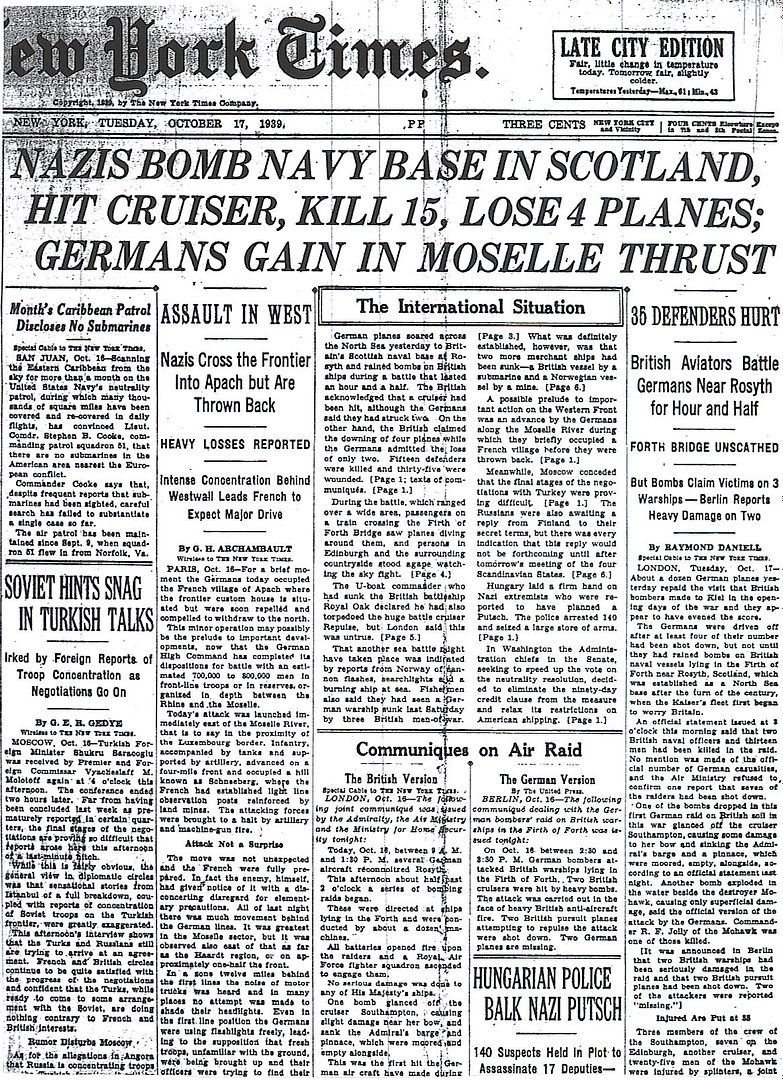
Posted on 10/17/2009 5:24:39 AM PDT by Homer_J_Simpson

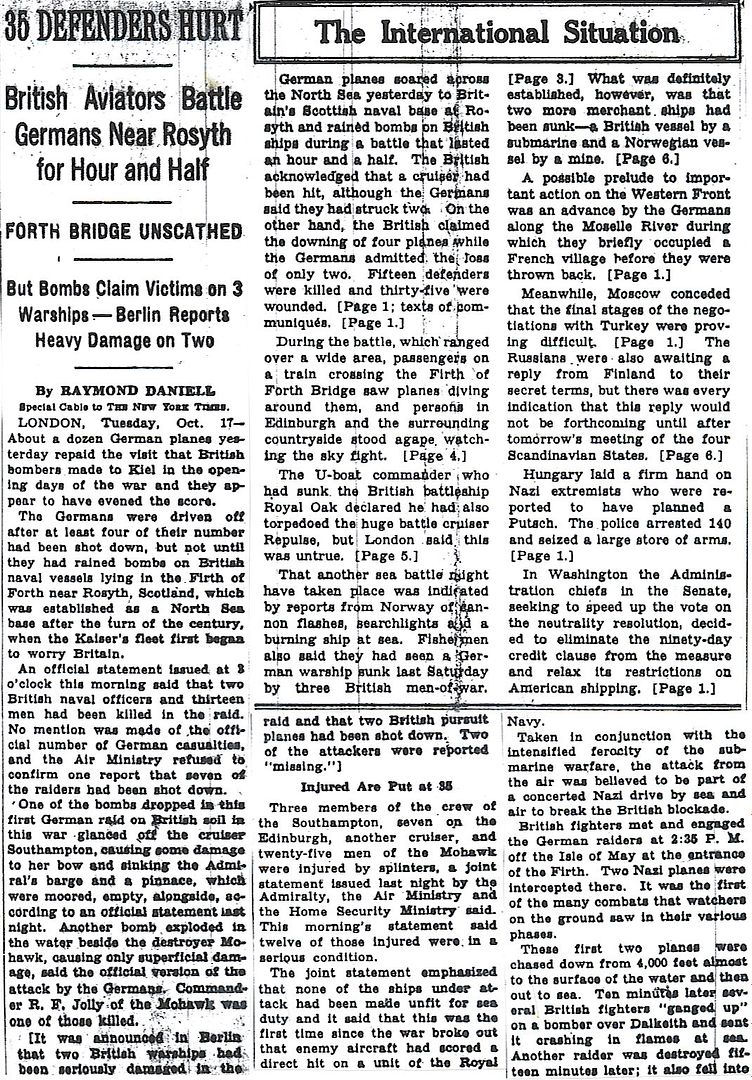
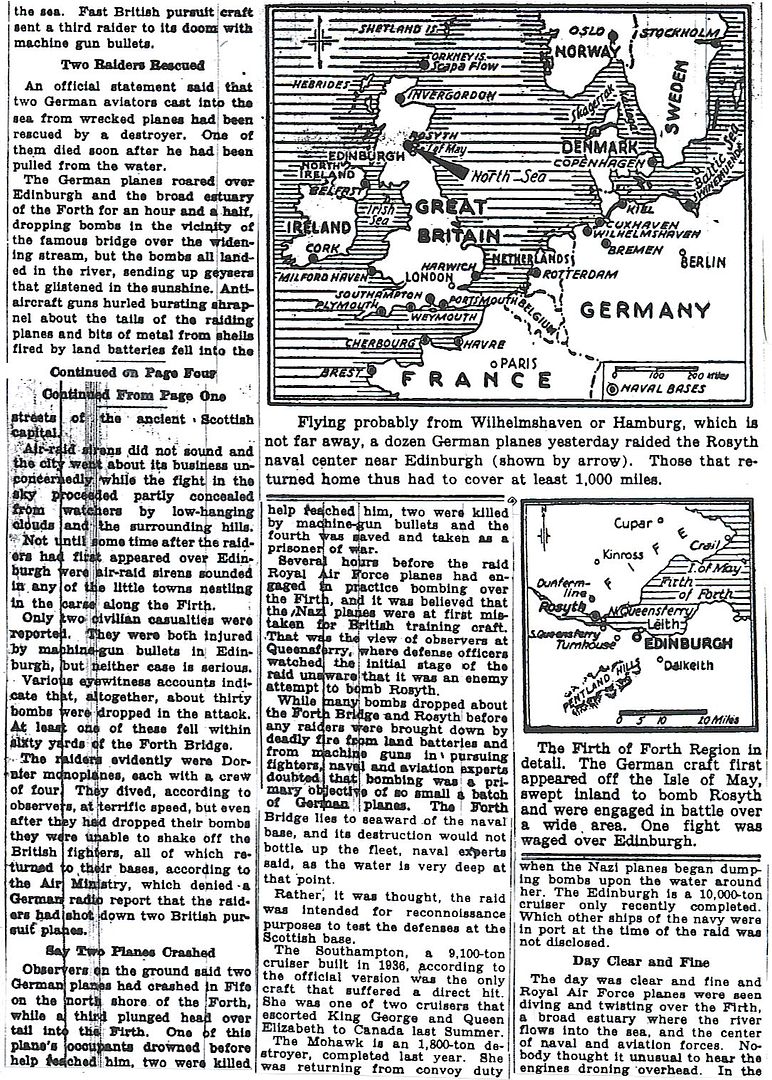

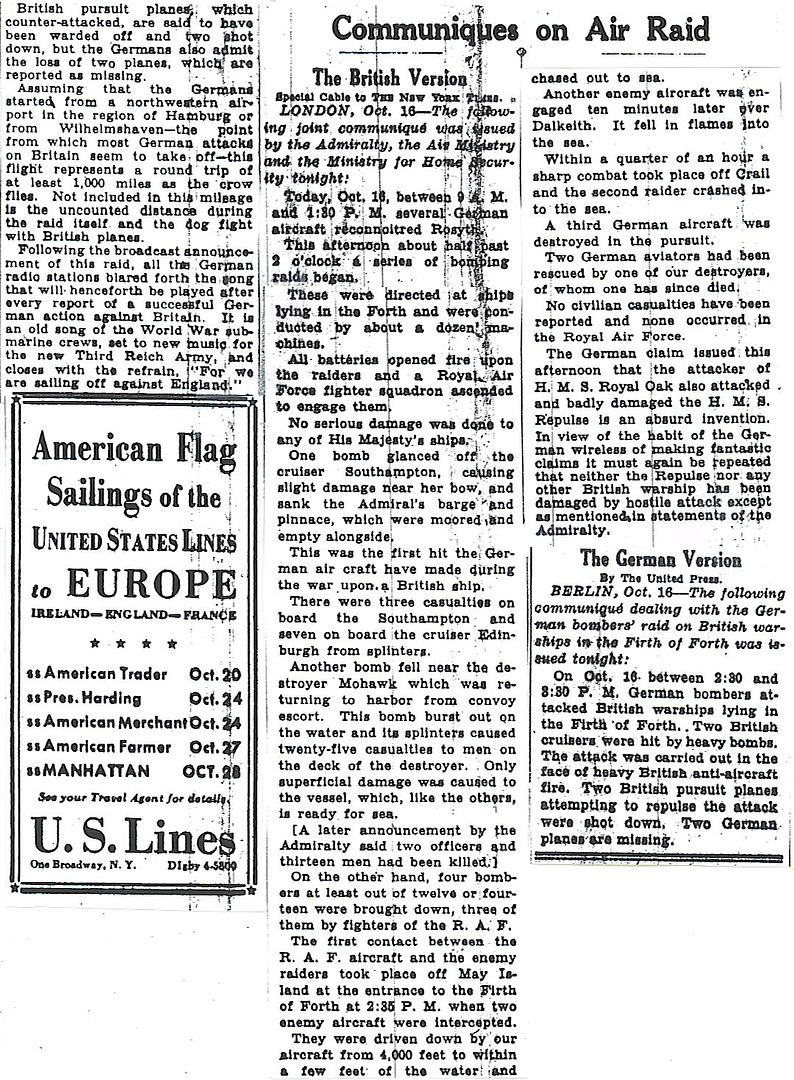
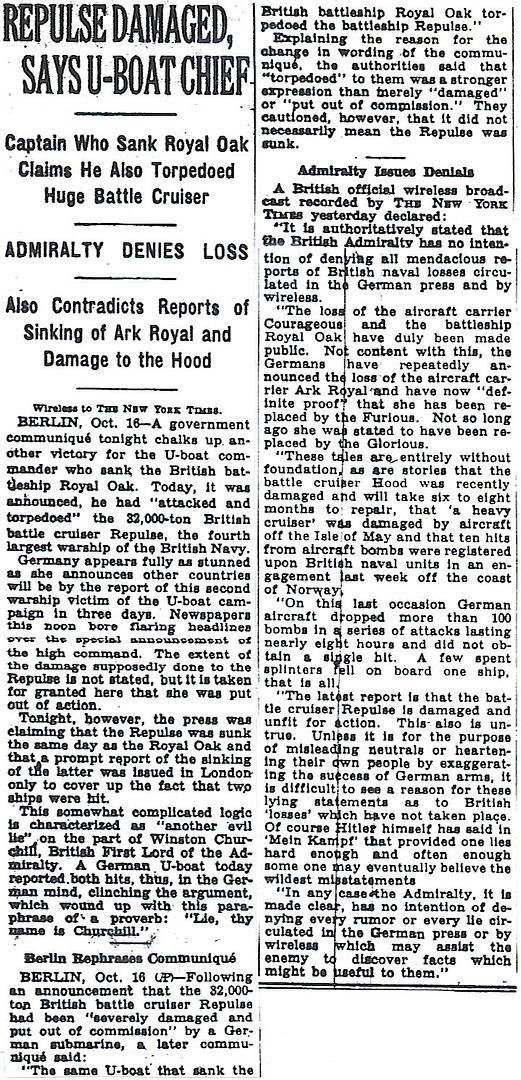
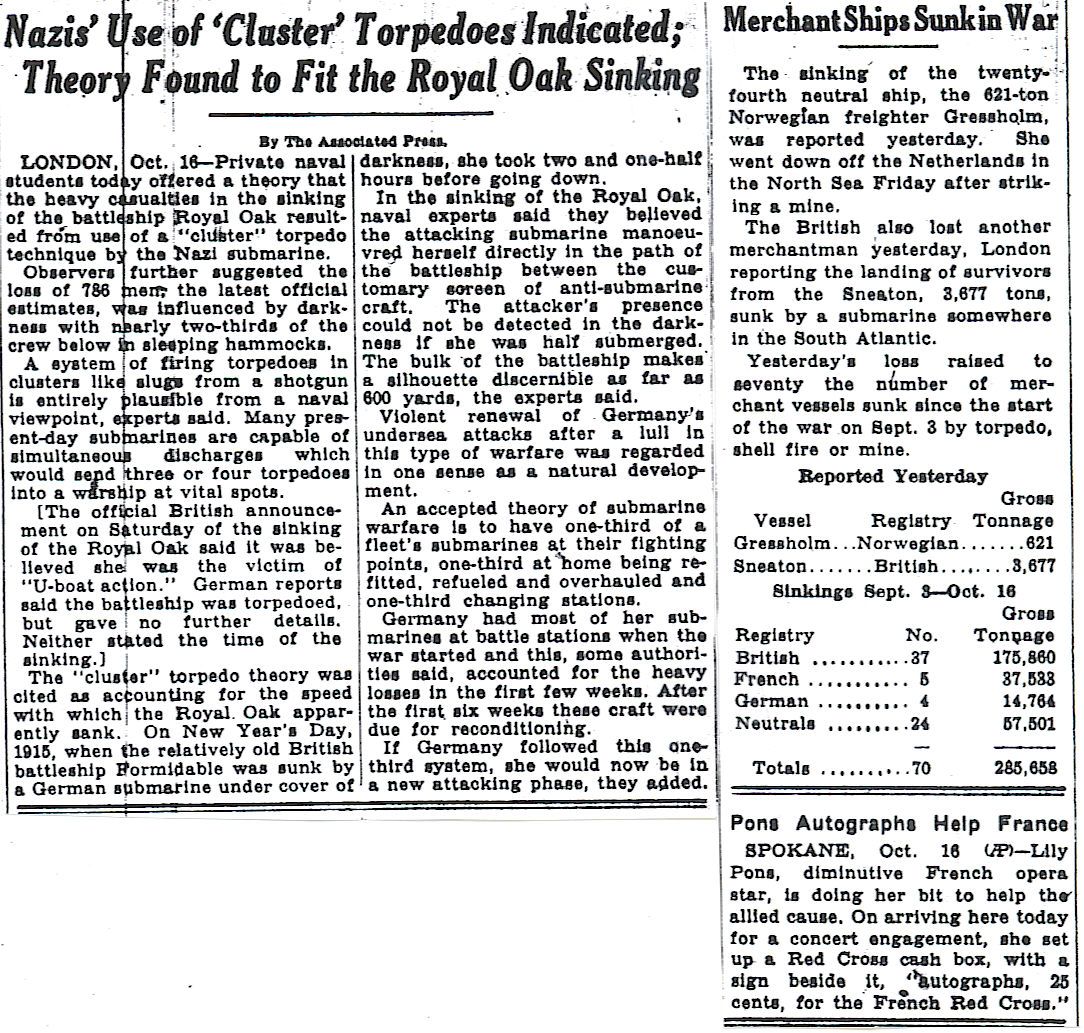
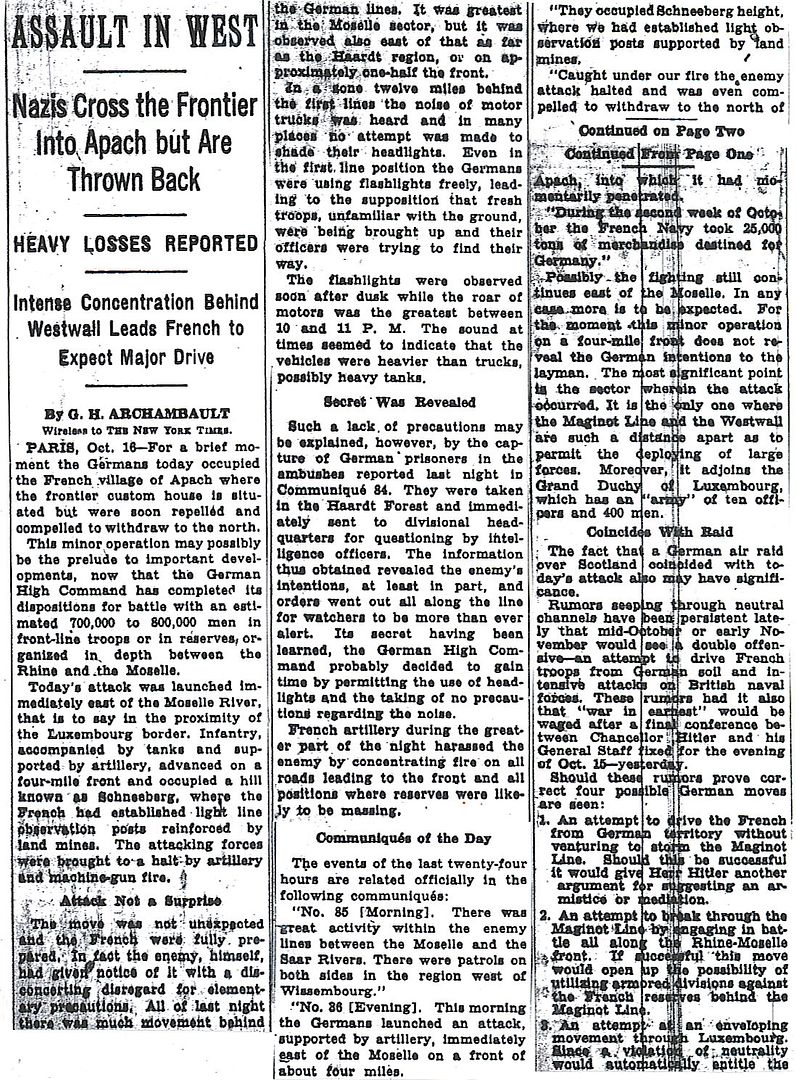
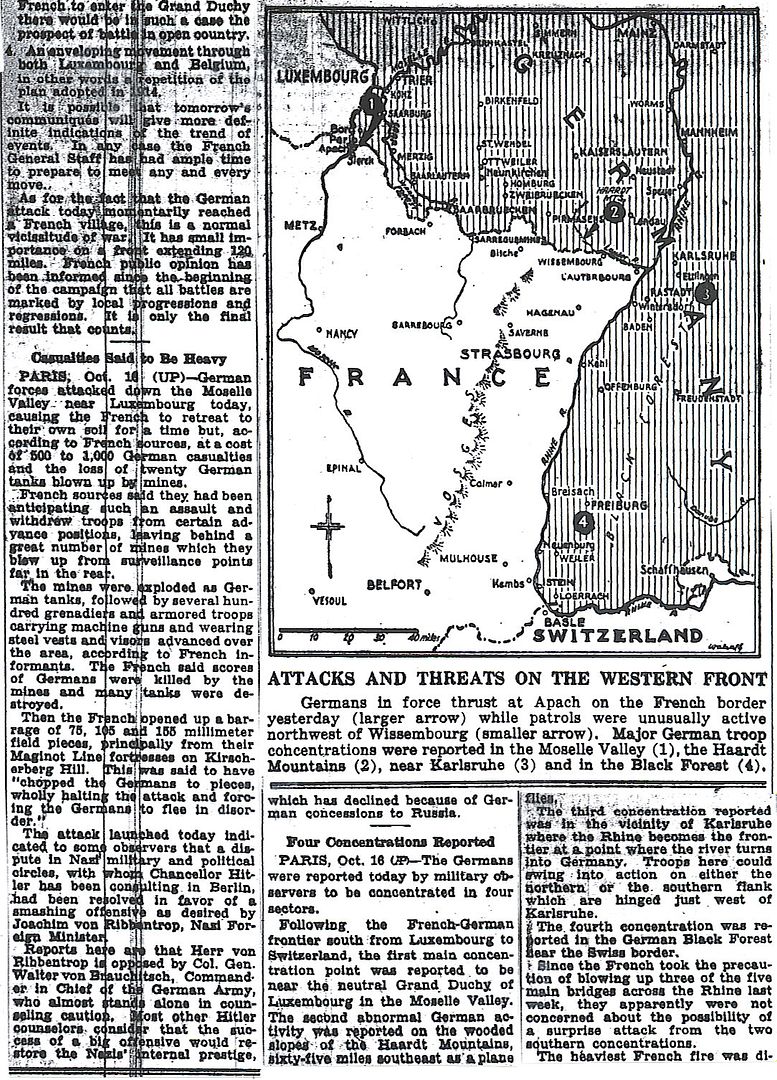
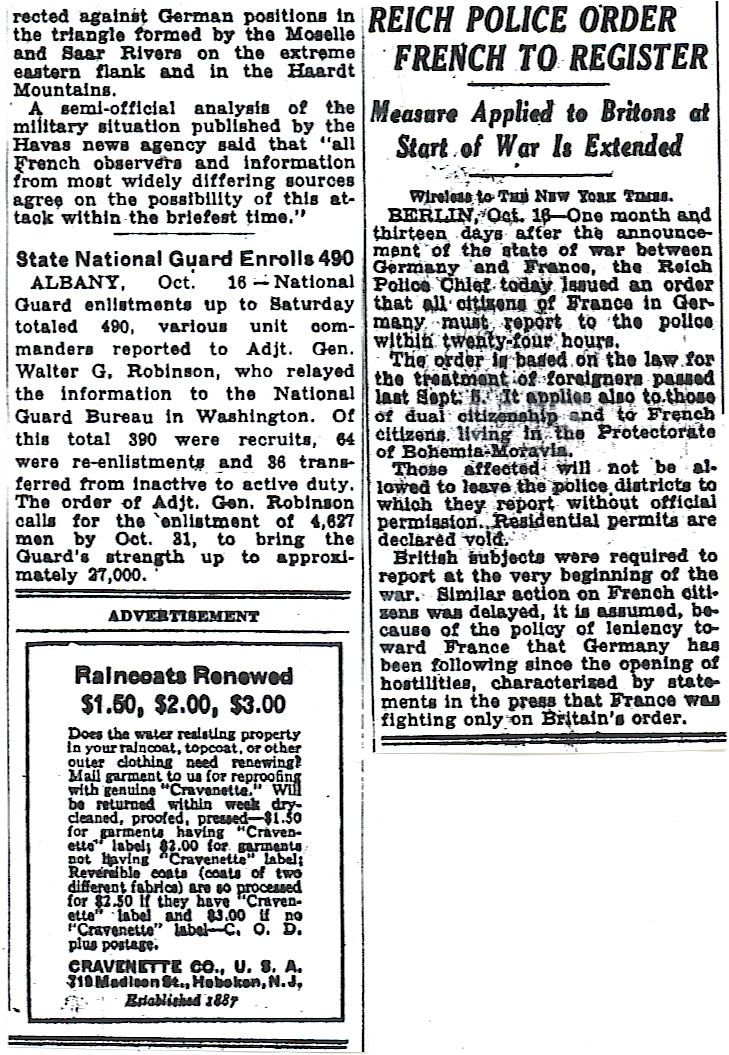
CONCLUSIONS of a Meeting of the War Cabinet held at 10 Downing Street, S.W.1, on Tuesday, October 17, 1939, at 11:30 a.m.
The First Lord of the Admiralty said that he had news of an air raid in progress at Scapa Flow, and warnings had been given at Rosyth and Humber, though these were probably on account of reconnaissance aircraft.
The Iron Duke, which had been demilitarized under the Naval Treaty, and was now in use as a depot ship in Scapa, had been hit. She was not armoured, and after the hit, had developed a list but had been beached. There were no casualties, but one of the enemy aircraft had been shot down.
There is no mention of the Repulse anywhere in the meeting notes so I she's probably all right.
Found this.
http://boards.history.com/topic/World-War-Ii/October-14-1939/520075253
At 0116 hours on 14 October 1939 the German submarine U-47 fired a spread of three torpedoes at HMS Royal Oak and the British seaplane tender HMS Pegasus lying at anchor in the harbour of Scapa Flow, turned around and fired a stern torpedo at 0121 hours. Prien misidentified the seaplane tender as HMS Repulse and claimed a hit, but a torpedo apparently hit the starboard anchor chain of the battleship and did not damage the ships. At 0123 hours, the U-boat fired a second spread of three torpedoes that hit HMS Royal Oak (Capt. William Gordon Benn, RN) on the starboard side and caused a magazine to blew up. The battleship rolled over and sank in 19 minutes in position 58º55’N, 02º59’W. The ship complement was 1208 officers and men, 833 of them were killed and there were 375 survivors.
Well, it was dark out.
HMS Repulse may have been at sea at the time. Some discussion here.
http://www.freewebs.com/hmsroyaloak/theroyaloaktimeline.htm
13/10/1939 17:34:00 Repulse to sea,
13/10/1939 22:49:00 Repulse crossed Moray Forth, and in a position 10 miles of Fraserburgh (ratray Head 174 deg Kinnairds head 210 Deg
14/10/1939 08:45:00 Repulse passes port boom defense at The Forth.
14/10/1939 09:02:00 Repulse passed beneath Forth Bridge
14/10/1939 09:46:00 Repulse secures to No 14 Bouy
14/10/1939 14:15:00 Repulse proceeds to Rosyth Dockyard
14/10/1939 15:40:00 Repulse Entered dry dock
15/10/1939 09:00:00 Repulse A start is made on pumping out the dock
15/10/1939 13:00:00 Repulse A start made to painting her bottom
17/10/1939 12:33:00 Repulse leaves dock
18/10/1939 12:33:00 Repulse sailed for Loch Ewe
I agree. Don't forget that it also served as essentially a cruise missile, well flying bomb at the very least. They strapped a Fw190 on top of an explosive laden 88 and would drop them on targets in the last desperate days of the war. These attacks were called Mistel attacks. Here's an account by Leutnant Eckard Dittmann of II./KG200 on a Mistel attack against a bridge over the Oder at Kustrin.
Suddenly, a river bend shimmers through the haze - the Oder! I had memorized the map of this area and recognized at once that I was a few miles too far south. Right - another 270 turn; that should lead me to the railway line and the bridges at the end of it! The haze and closed in and all ground detail disappeared once more. Mistel was now way below 1,000m and must have been clearly visible to the Ivans who were blazing away at me like mad.The rest happened very quickly. The ground features appeared like shadows from out of the haze and then there was a darker line - the railway. I had flown past it. Then in the next moment I caught sight of a bridge, then several. The target! I banked steeply to starboard, switched on the steering controls, uncaged the gyro, made a quick correction - there was no time for a really 'clean job' - then I had to release the Ju 88.
There was a band and I felt a blow from beneath me. My Fw 190 suddenly went into a roll to port and I thought they had got me. But the aircraft simply needed retrimming and I soon had her under control again. With the haze and all the tracer, for a while I could not tell which way was up and which was down. I turned towards the lighter, redder part of the sky - that must have been the low-lying sun. The flak followed me all the way.
Price, Alfred. The Last Year of the Luftwaaffe: May 1944 to May 1945. p. 167, 169.
I am sitting in my office/study surrounded by a huge library of of WW II history books with the bulk of the stuff focusing on ships and navies. Probably a thousand volumes, give or take. Been collecting and studying them for 45 years. I hardly look at them any more, since so much data is available online.
Now that I’m almost 60 years old, I need to think of what I need to do with all these books. Don’t need the money, so selling them is out.
I’m thinking if I could find the proper library or some young deserving student to donate them to would make me feel really good. I’ve talked to the curator at the USS Alabama in Mobile, and he seemed interested.
Any ideas from my fellow FReeper history buffs?
That would make since being that I do remember mention of the Pegasus from the War Cabinets document for the 15th I think.
Look like your right. Well, she will become a more central story come December of 41.
My first instinct is to advise you to give them to a fellow freeper who happens to be working towards a masters in military history with a concentration in World War II and plans to continue on to a PhD. I happen to know one. ;)
But realistically, it may be worthwhile to see if the University Library(s) in your area are interested in them.
nice looking ship
“superficial damage” killed crewmembers, including the Commander. I guess humans are expendables in war.
833 killed.
Thats a big number for a “phony war”
There are other ships besides the SS Alabama serving as museums, I think there are a couple in Texas ports.
Incredible story of first World War Two air attack on Britain
Oct 17 2009 Annie Brown
A PAIR of wreaths from anonymous Scottish women graced the graves of the German airmen shot down in the first air raid of World War Two.
One message read: “To two brave airmen from the mother of an airman”, and the other stated simply: “With the deep sympathy of Scottish mothers”.
In the poignant inscriptions, there was no ally or enemy, just a heartfelt compassion for a mother’s loss, regardless of geography.
The raid on Rosyth had been launched on October 16, 1939, and was to become a significant moment in the war, where crucial lessons would be learned that would be taken into the Battle of Britain.
The German planes were engaged by RAF Spitfires from 602 (City of Glasgow) Squadron based at Drem, East Lothian, and 603 (City of Edinburgh) Squadron from Turnhouse.
Two of the enemy JU 88 dive bombers were shot down, killing four of their crew, and three British ships were damaged with 16 sailors killed.
Two of the German dead, Under Officer Kurt Seydel, 19, and his Observer 17-year-old August Schleicher were buried in Portobello Cemetery overlooking the icy waters of the Firth of Forth where they had fallen.
Their coffins were draped in the Nazi flag, and a cortege of British airmen and dignitaries followed, as pipers from 602 and 603 played Over The Sea To Skye.
Among the 10,000 who lined Edinburgh’s streets, a policeman gave a sombre salute. The chaplain for 603, Reverend James Rossie Brown, delivered a moving address at their graveside and later he would write to their mothers to assure them that their sons had been buried with full military honours.
Military historian John Weal said: “At the beginning of the war they were honoured in that way.
“This was the first raid. Later they were buried where they came down without pomp and ceremony.
“But there was always a mutual respect between the German and the British airmen and similar respect was shown in the burials of the first RAF who were shot down by the Germans.”
This chivalry between foes, in the period of relative calm known as the Phoney War, has been largely forgotten, overtaken in history by the horror of human sacrifice which would follow.
The raid of October 16 was unexpected and would mark the beginning of the end of the Phoney War.
That morning Joe Parker, now 89, and then a leading aircraft man went through the daily routine inspection of the Spitfires of 602 squadron.
He had just returned to the duty room and was contemplating breakfast when the Red Alert came through, placing the crews on standby.
Even when the call to scramble came,the men weren’t convinced there would be an enemy engagement.
“We thought it was just another false alarm,” said Joe.
“It wasn’t until later when the crews returned and we saw the black of the gun ports that we knew there had been action. The crew were excited. We all were. We were young and daft and to us it was a buzz.”
A dozen of the newly manufactured German “Wunderbomber” aircraft, the Junkers, had taken off around midday from their base on Westerland on the island of Sylt, just off the German coast.
They flew in groups of three and their target had been chosen by Hermann Goering himself.
He had impressed upon his friend, the Group Commander Hauptmann Helmut Pohle, that results were needed and that the Junker should prove its worth.
Second in command was Lieutenant Hans Sigmund Storp, a veteran of the Spanish Civil War attack on Guernica.
Their target was the pride of the British fleet, HMS Hood, but they were under orders from Hitler that the Luftwaffe were only allowed to hit ships that were at sea or anchored in the Forth. At this point the Fuhrer still hoped that the there could be some accommodation with the British he so admired and ordered that civilian casualties must be avoided at all costs.
Earlier that morning, two German Heinkel 111 reconnaissance aircraft had seen a large British battleship about to enter the Firth of Forth and assumed it was the Hood.
The German intelligence was wrong, not only about the Hood but also about there being no Spitfires in Scotland.
The battle which would follow was to be the first major test of the Spitfire against the Luftwaffe.
The JU 88 was a new plane too and its pilots were well trained, many of whom had been involved in the bombing of Poland and the Spanish Civil war.
The RAF squadrons, 602 and 603, were reservists, they were volunteers who had been firemen, lawyers and farmers and, unlike their adversaries, they weren’t used to combat conditions.
As he looked down to Rosyth 22,000 feet below, Pohle could see that the Hood was already in dock. He later recalled that it had been a dream target.
Hesaid: “A stationary target, perfect for dive bombing, but we were strictly forbidden to attack this sitting duck.”
But there were other targets in the open waters of the firth just below the bridge,British cruisers HMS Southampton,HMS Edinburgh and the destroyer HMS Mohawk.
Pohle picked out the Southampton and tipped the nose of his plane into an 80 degree dive. He later wrote: “Suddenly there was an almighty crack as the roof of the canopy flew off, taking the rear gun with it.”
Despite the intensity of the wind, which now battered against his face, he held his aircraft steady and planted his 500KGbomb on the Southampton.
The bomb failed to go off, instead slicing through three decks and flying out the flank sending the ship’s barge into the air.
Just afterwards, Lieutenant Hans Storp led the second section to attack the ship from the west. Then the German wireless operators issued the fateful warning that a squadron of Spitfires were heading their way.
The Scottish men who flew these planes were young and dashing and what they lacked in combat experience they made up for in courage.
Flight Lieutenant Patrick Gifford, of 603, fixed Storp in his sights, fired, hitting his port engine and killing his gunner, sending the plane hurtling to the ocean.
Gifford had shot down the first enemy aircraft over Britain in WWII and few could have fitted the role of hero more comfortably.
He was lawyer from a middle class background, handsome behind the wheel of his open top Frazer Nash sports car.
Once for a bet, he claimed he would leave the clock tower at Castle Douglas at 10am, head for Turnhouse, almost three hours away, and be back over Castle Douglas by midday in a plane. He won the bet, of course.
Gifford used to park his car and ask the local children to look after it. Bill Simpson,who is writing a biography of Gifford said:”The wee boys adored him.
“He seemed to them to be a daredevil. He was only about 5ft 8 but he was considered to be very handsome.
“In the thirties, when men like Gifford joined the auxiliary air force, it was like a flying club. They were very privileged young men. The officers and the other ranks didn’t mix. But when it came to go to war they stood up to the plate and many lost their lives.”
Later, in May 1940, Gifford would lose his, shot down over the fields of France, his body never recovered.
Nine minutes after Pinkerton’s hit, former farmer, Flight Lieutenant George Pinkerton of 602, claimed the second bomber, taking down Pohle and killing his three crew.
Pohle said: “I didn’t have a chance to take defensive action, our left engine was hit almost immediately.”
The broken bomber plunged into the water three miles east of Crail.
Pohle was rescued, bleeding from facial wounds suffered in the crash. He was taken to the Military Hospital at Edinburgh castle where he was nursed back to health, beforehe was transferred to the POW camp at Grizedale Hall in the Lake District where he saw out the rest of the war.
As Pohle plunged to the Forth,HMS Mohawk was under attack,narrowly missed by bombs but hit by shrapnel and machine gun fire.
The Mohawk lost sixteen sailors but the Edinburgh was barely damaged .
Witnessing the spectacle had been the passengers of a train still trundling across the Forth Bridge. Fortunately, after Hitler’s decree, the bridge was deemed off limits.
Edward Thomson, then a young boy, was on board the train.
He said: “I was in the corridor with an older boy called Jack Thomas from Edinburgh. We were looking downstream to the right of the carriage and were trying to identify some of the fleet at anchor below the bridge.
“Almost simultaneously there was a giant waterspout as high as the bridge alongside one of the capital ships and a barge tied up alongside it seemed to fly up in the air. In later life I discovered the ship was the HMS Southampton.
“The German bombers were in plain sight only a short distance away flying parallel to the bridge. Meanwile, the train stopped briefly and as it did so the painters and riggers working on the bridge scrambled from the scaffolding and made for shelter.”
There had been no air raid warning given and so the dogfight was watched by civilians across Edinburgh. Some were hit by shrapnel. John Ferry, then a worker on the Silverknowes army camp, said it hit him on the leg “like a hammer”.
In a gentlemanly gesture, Pinkerton and Gifford visited Storp and Pohle at Edinburgh castle. Pohle appreciated the gesture and thanked them for coming, stressing they were all pilots together.
Squadron Leader Bruce Blanche, Royal Auxiliary Airforce (retired) is chairman of the 603 Association.
He said before the Rosyth raid there had been controversy about the idea of an auxiliary force but any dubiety disappeared after their remarkable performance at Rosyth.
Crucially, lessons were learned from the attack, which both the Germans and the British would take into future battles.
Bruce said: “This was a significant raid. It was the beginning of the end of the Phoney War, the chivalry pretty much disappeared after that and from then the gloves were off.”
Headded:”It was also a wake up call for Britain and a lot of lessons were learned from that raid.
“It was established the Spitfire were shooting at the JU 88 from too far a range. They really had to get closer. Aerial tactics were refined “All of these things had a beneficial outcome in the Battle of France and the Battle of Britain.
“It was also an indication of what the Luftwaffe could do. It was a warning for us to improve our air defense system and a wake-up call for the civilian authorities to increase civil defense. Barrage balloons sprouted up all over the place after that.”
Pinkerton and Gifford were given the Distinguished Flying Cross.
Bruce said: “The auxiliaries had proved the doubters wrong.”
Tuesday, 17th/Wednesday, 18th October 1939 N45
The German destroyers ‘Galster’, ‘Eckholdt’, ‘Lüdemann’, ‘Roeder’, ‘Kunne’ and ‘Heidkamp’ assembled in Wilhelmshaven Navy Yard, took on their cargo of 60 mines each (Except ‘Heidkamp’ which as an escort carried none) and sailed at about midday on the 17th, racing at first, northwards from the Shillig Roads at 30 knots as a deception, then at dusk turning westwards for the target area, the mouth of the Humber.
In the early hours of the 18th the five destroyers began their task, between the Humber Estuary and the Withernsea Light - the ‘Heidkamp’ standing by. Nothing untoward happened and on completion, the destroyers steamed for home at high speed, undetected. This minefield of 300 mines, eventually claimed seven ships.
-Night 45. All times BST. Blackout begins: 18.05, ends: 07.39
NAVAL EVENTS-Tuesday, 17 October
Light cruiser SHEFFIELD departed Loch Ewe for Northern Patrol in the Denmark Strait, arriving back on the 22nd after capturing German steamer GLORIA.
Four light cruisers were on Northern Patrol between the Orkneys and the Faroes, four AMCs between the Faroes and Iceland, and three AMCs in the Denmark Strait. The armed merchant cruisers were ASTURIAS, AURANIA, CALIFORNIA, CHITRAL, RAWALPINDI, SCOTSTOUN, and TRANSYLVANIA.
Convoy OA.21 of 21 ships departed Southend escorted by destroyers VANSITTART and WIVERN, which remained with the convoy until it dispersed on the 22nd.
Convoy OB.21 departed Liverpool escorted by destroyers WINCHELSEA and WITHERINGTON.
Convoy BC.10S of steamers BARON GRAHAM, BEAVERDALE, BELLOROPHON (Commodore), CITY OF DERBY DORSET COAST, EILDON, ERATO, FLORISTAN, GLAMIS, GLYCAON, MERLAND, PEMBROKE COAST, TASSO and VOLO departed the Loire, escorted by destroyers MONTROSE and VIVACIOUS, and arrived safely in the Bristol Channel on the 19th.
Anti-aircraft cruiser CALCUTTA departed Grimsby and arrived back on the 18th.
Destroyer BEAGLE attacked a submarine contact.
French large destroyer LEOPARD, which had been covering minelaying in the Pas de Calais area, returned to Brest on the 17th. Large destroyer JAGUAR sailed from Dunkirk on 1 November and with large destroyer PANTHERE, which had been at Cherbourg under repair, also arrived at Brest, but on the 2nd.
U.19 laid mines off Inner Dowsing near Yarmouth during the night of the 16th/17th, on which three merchant ships were sunk.
Three German aircraft bombed Scapa Flow, one of which was shot down by destroyer ESKIMO. Two near misses damaged old battleship IRON DUKE which took a heavy list and bomb blast damaged her electrical installations. She was towed into shallow water, settled onto the sea bed and ESKIMO provided electric power. Destroyers SOMALI and ASHANTI were also at Scapa Flow at the time of the raid, and later in the day, four more aircraft attacked, near-missing ASHANTI, but causing no damage.
Destroyer JUNO fired on German aircraft shadowing her SW of Farne Island. British aircraft came to her assistance and shot down a Dornier flying boat.
German destroyers PAUL JACOBI, THEODOR RIEDEL, HERMANN SCHOEMANN and torpedo boats LEOPARD, ILTIS, WOLF conducted an anti shipping patrol in the Skagerrak from the 17th to 19th.
U.37, U.46, U.48 attacked convoy HG.3 off Cape Trafalgar while it was protected by aircraft. Steamer YORKSHIRE (10,184grt) was the convoy commodore ship with Rear Admiral D M T Bedford Rtd as commodore on board and she carried military families which had been embarked from steamer NEVASA (9213grt) at Gibraltar.
U.46 attacked YORKSHIRE without success, but she was then sunk by U.37 with the loss of 58 lives, including 25 crew. Steamer CITY OF MANDALAY (7028grt) was also sunk by U.46, with seven crew lost and 17 survivors being picked up by Norwegian whaler SKUDD IV.
Destroyers WAKEFUL, ELECTRA and ESCORT were ordered to attack a submarine reported near the convoy. The last steamer was CLAN CHISHOLM (7256grt), sunk by U.48, 150 miles from Cape Finisterre with the loss of four crew. Survivors from all three ships, including Rear Admiral Bedford, were picked up by American steamer INDEPENDENCE HALL (5050grt) and taken to Bordeaux.
ELECTRA and ESCORT had departed Dover on the 13th and joined the convoy on the 18th from OA.19. In addition, destroyers ARDENT and ACASTA left Dover on the 20th and joined.
Convoy HX.5 departed Halifax at 0900 escorted by heavy cruiser YORK and Canadian destroyers FRASER and ST LAURENT. RCAF flying boats accompanied the convoy until 1800/17th. ST LAURENT was detached at 0830/18th, FRASER at 1630/19th, and YORK at 1000/19th, arriving back at Halifax the same day. Light cruiser EMERALD departed Halifax on the 17th as ocean escort, and she arrived at Portsmouth on the 29th. YORK left Halifax again on the 22nd to support the convoy and search for German battleship DEUTSCHLAND. Destroyers GRAFTON, GALLANT, WESSEX escorted the convoy on the 28th and 29th, when it arrived at Liverpool.
Convoying in the Mediterranean was discontinued:
(1) destroyer DUCHESS and sloop FOWEY, awaiting convoy Green 5, were sent from Gibraltar to Malta, arriving on the 20th
(2) destroyer DIANA and sloop DEPTFORD, en route to Port Said from Blue 5, were sent to relieve destroyers GRENVILLE and GIPSY on contraband patrol
(3) destroyer DUNCAN from Blue 4 was sent to escort battleship RAMILLIES, relieving destroyers GRAFTON and GALLANT
(4) destroyers DAINTY and DEFENDER departed Malta on the 18th to escort RAMILLIES, which reached Alexandria on the 20th
(5) French destroyers CASSARD and KERSAINT returned to Bizerte, and
(6) destroyers DECOY and DELIGHT were at Malta. After refitting, DELIGHT reached Gibraltar on the 31st for escort duty, and DECOY, her refit completed on 3 November, left Malta to escort steamer NEVASA to Marseilles.
I noticed from my TCM schedule that they are showing "Pursuit of the Graf Spee" at 9:30 pm PDT today. From 1957. Starring John Gregson, Anthony Quayle, and Peter Finch. I don't recall seeing it so this is not an endorsement - just a notice.
very very good post
One of the ships that was in the actual battle was used in the film.
http://www.imdb.com/title/tt0048990/trivia
Ships used in the film: HMS Sheffield as HMS Ajax, INS Delhi (HMS Achilles 1933-41, HMNZS Achilles 1941-46) as HMS Achilles, HMS Cumberland as HMS Cumberland, Heavy Cruiser USS Salem as the German pocket battleship Admiral Graf Spee. Light cruiser HMS Jamaica played the played the part of heavy cruiser HMS Exeter.
Tank-buster 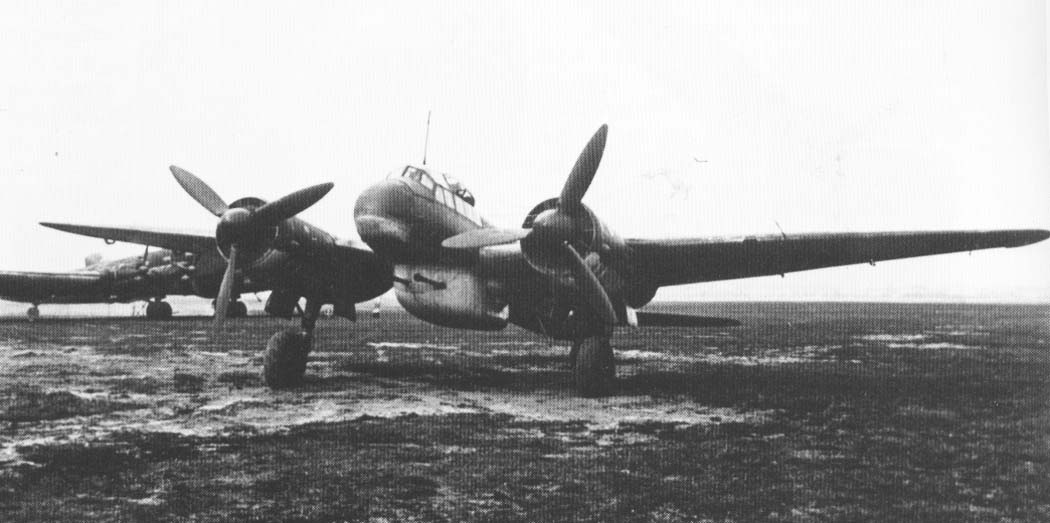
Disclaimer: Opinions posted on Free Republic are those of the individual posters and do not necessarily represent the opinion of Free Republic or its management. All materials posted herein are protected by copyright law and the exemption for fair use of copyrighted works.